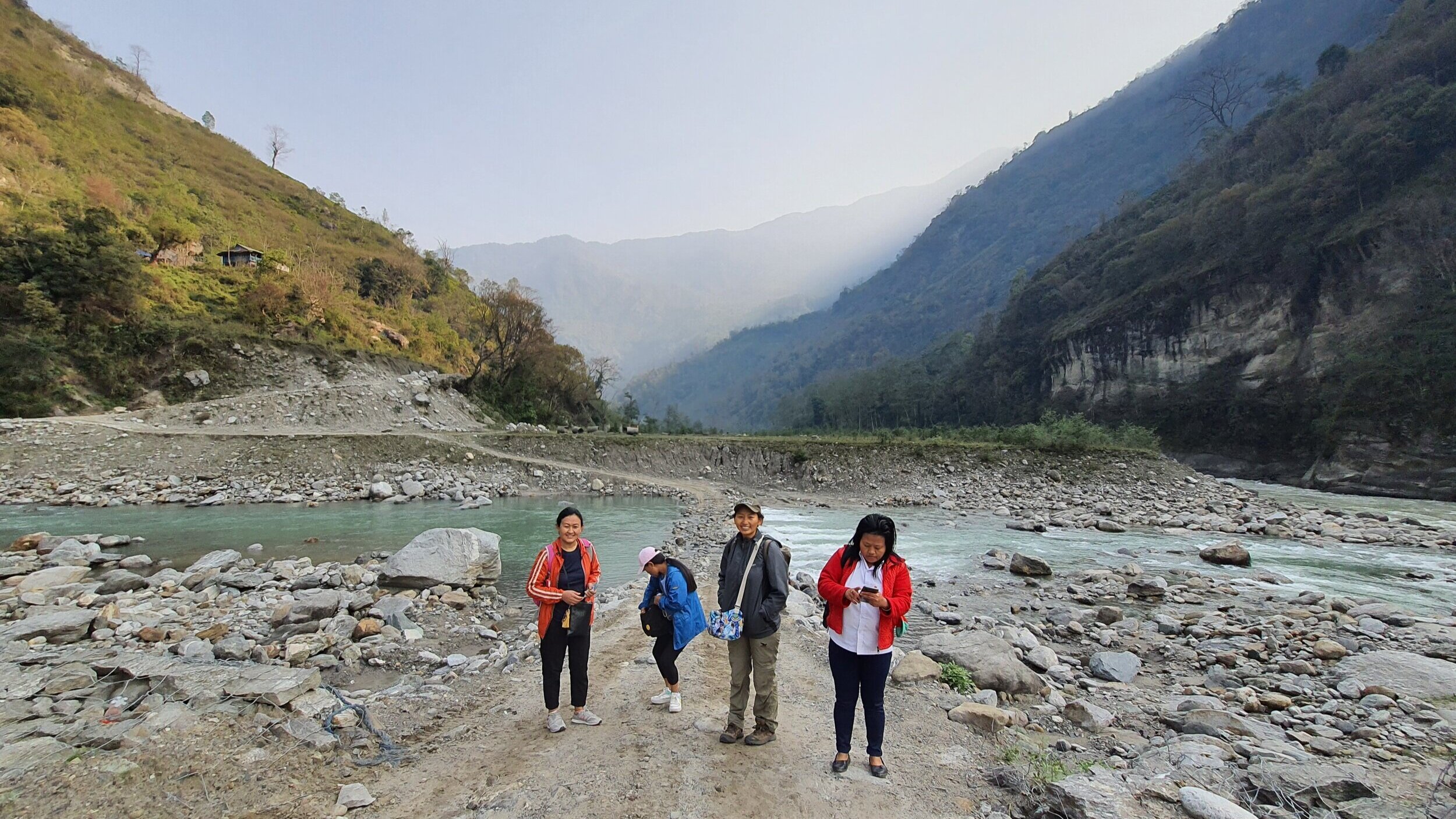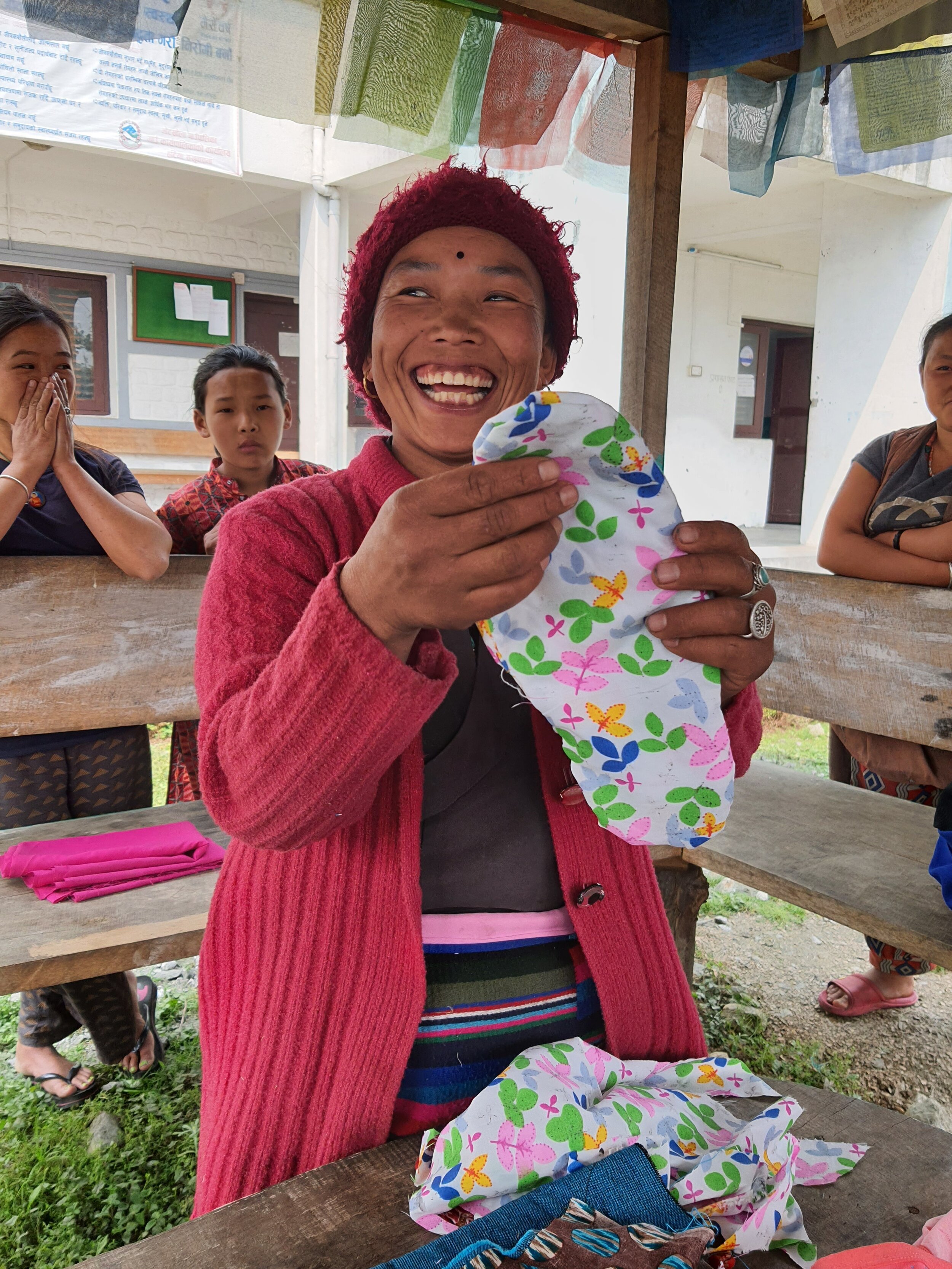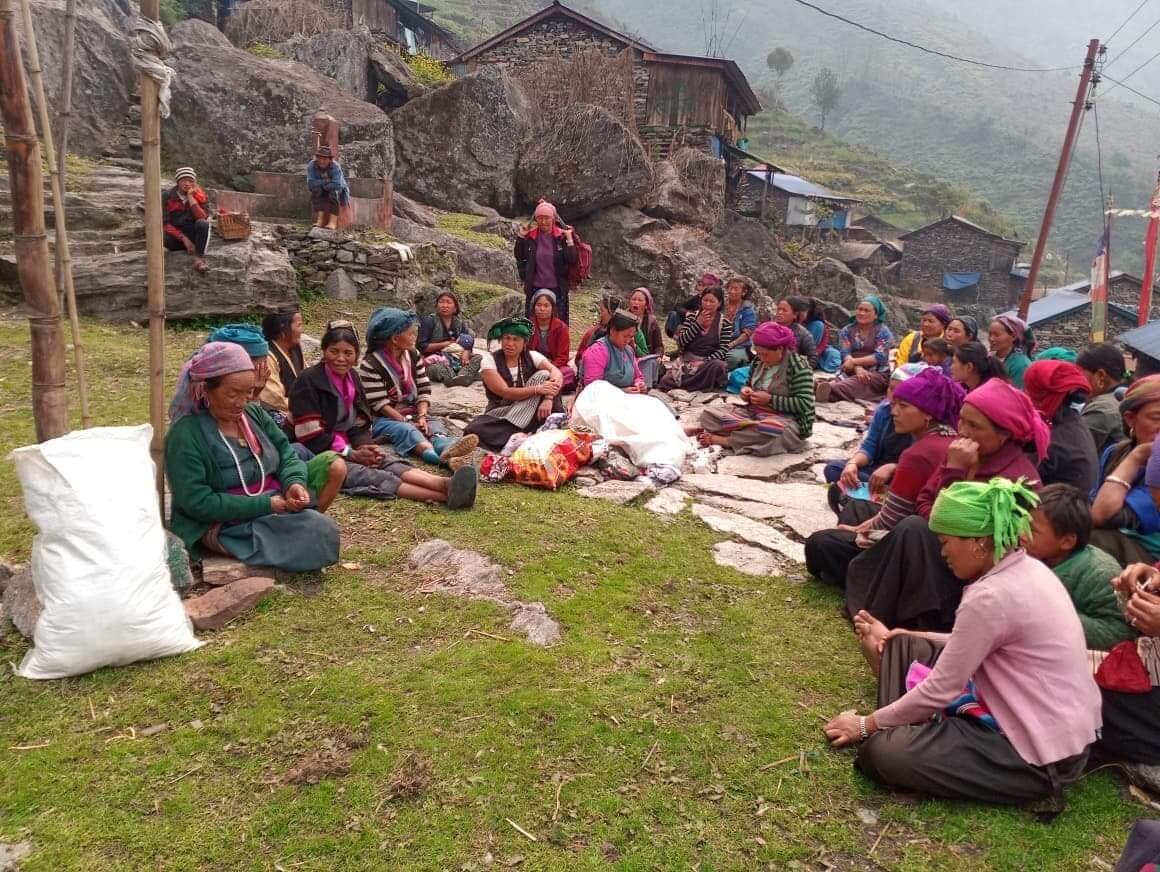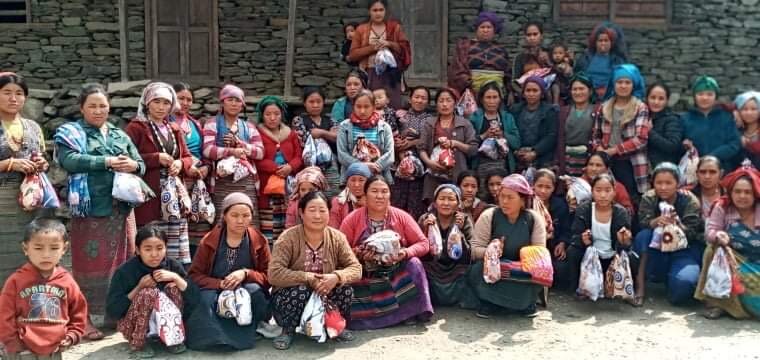by Kesang Yudron
From left to right: Samjhana Lhomi, Somi Lhomi, Kesang Yudren and Chandrakala Rai
Surrounding us there is beauty and there is fear. The majesty of the mountains above us and the valleys below inspire awe in the natural world. The simplicity and lack of modernity in these isolated valleys of Sankhuwasabha, Nepal, equally inspire wonderment at human survival and endurance. Tucked snugly on the northeastern edge of Nepal, Barun Valley National Park is home to towering snow capped mountain peaks, high waterfalls and lush green forests that offer a remote wilderness experience that has been relatively untouched by humans.
The inhabitants of this valley are Lhomi people, an indigenous community that have lived and subsisted on farming barley, potatoes and millet and traded wild herbs and plants for medicine for centuries. Living in difficult terrain with limited resources has meant many Lhomi women endure additional issues during menstruation. Historically, the women have been known to “free bleed” and/or use scraps of cloth which are hard to come by. In more recent years, the younger women have taken to using disposable sanitary pads but these are expensive to procure and their disposal leads to environmental challenges.
Chhing Lhomi – Vice Chairperson of National Indigenous Federation (NWIF)
Given these circumstances, the people from and around the region have struggled to connect with organizations or networks for support and resources. This need was highlighted by Chhing Lhomi, vice chairperson of National Indigenous Federation (NWIF), the chairperson of Lhomi Women Welfare Forum (LWWF), and the Himalayan Indigenous Society Nepal (HIS-Nepal). These organizations strive to work on behalf of indigenous women through social justice and women empowerment programs. Through my conversations with her, she was able to express the value and need for education on menstrual health and hygiene for the Lhomi women. That is how we set our plan to go to Sankhuwasabha.
As CCF's Menstrual Hygiene program manager, I approached the CCF Board to see if they would be willing to work on this project. Since this program fell directly within CCF’s mission, board members talked with Chhing Lhomi and myself and agreed to fund the trainings, kits, and distribution of the CCF funded & newly completed Menstrual Hygiene manual.
With 2200 pounds of goods consisting of 3000 Menstrual Cloth Kits (2-day pads, 1 night pad, 5 liners, 1 soap, 2 underwear, 1 bag), fabrics, menstrual hygiene manuals and stationery supplies, we set out for Khat Bari, a region in Arun Valley. Preparation for this undertaking was challenging and was years in the making. To prepare we:
Preparing kits for the Arun Valley
Procured the PUL (water proof) fabric that prevents the pads from leaking from China,
Bought all the materials for the kits, refining the pattern every time we got feedback,
Trained four women for two years in how to sew menstrual kits (giving them sustainable income that uplifts them from poverty)
Created and published a Nepal centric Menstrual Health and Hygiene training manual in both Nepali and English for participants and communities to have as a resource and,
Figured out the logistics for transporting everything into a remote area with no telecommunication or roads during the Covid-19 pandemic.
Each step of the way was carefully executed. With support and funding from Conscious Connections Foundation, a four-woman team of leaders, and the support of the local Lhomi village women, we were extremely well prepared to make this expedition happen. Together, our goal was to raise awareness on Menstrual Health and Hygiene and introduce rural girls/women to reusable, environmentally sustainable products while at the same time teaching them how to make their own cloth pads, helping their communities become more self-reliant. With that mission in mind, our group of four women, two locals, Somi & Samjhana and Jenny Shakya and myself took a 12 day trip into the Arun Valley.
The Nepali version of Planes, Trains, and Automobiles – We transported over 3000 Menstrual Kits almost 100 miles.
Together, we covered 80-90 miles hiking through deep gorges and waterfalls along Arun River. The Arun river enters from Tibet at an elevation of about 3500 meters (11,500 feet) and flows south across the district, forming one of the world’s deepest valleys relative to Makalu mountain at 8481 meters (27,825 feet) to the west and Kanchenjunga mountain at 8586 meters (21,869 feet) to the east. As we hiked up and down the evergreen trails, we were greeted by ‘Tashi Delek’ a Tibetan phrase which means, “May you be happy in the here and now” by friendly locals who asked us where we were headed as they sped past us on their daily walks.
The locals we interacted with were friendly and had a matter of fact way of looking at life. Despite heavy rains and frequent landslides that blocked roads and made life precarious, they seem to be more joyful and accepting of the vicissitudes of life.
In rural societies with limited access to technology and modernity, people seem to come together to help each other thrive and survive. As we moved from village to village, the locals helped us find a caravan of mules – the primary means of bringing the much needed menstrual supplies into the hinterlands of Sankhuwasabha. We started our first of three training sessions in Hattiya village followed by a similar training in Lingum village. We were welcomed by the Bhot Khola District Department of Education. Women pre-organized by Chhing Lhomi and myself came from eighteen neighboring villages to the trainings. We were interested in knowing their views, beliefs about menstruation and teaching them what we knew in the process. The participants were from all ages from 14 year old girls to 60-70 year old grandmothers. Lhomi women have less social and religious restrictions compared to Hindu women in Nepal, but still have limited access to menstrual products which makes them vulnerable to menstrual related illnesses.
Menstruation is considered a natural process within the realms of Buddhism and some Lhomi women see menstrual blood as a powerful tool during Buddhist tantric rituals. Several female Tibetan deities, Dhakinis, are associated with menstruation but this portrayal is not widely acknowledged in Tibetan culture. Palden Lhamo is an icon in Tibetan Buddhism and represents the protector goddess whose wisdom and compassion overcome every obstacle. She is depicted riding a mule across a sea of menstrual blood serving as a metaphor for fertility.
Despite the strong female Dhakinis in Buddhist tradition, the Lhomi women talked about how gendered roles still suppress women in Lhomi culture. Giving space during these trainings to the voices of the indigenous Lhomi women was a vital part of the learning process. Room was given for them to talk about their personal health issues without feeling embarrassed or ashamed. Samjhana Lhomi, our trainer from Bhot Khola helped translate some of the topics into Lhomi and made the topic of menstruation lively with shared laughs and personal menstruation stories. Sonam, a Lhomi woman, said how her husband loves it when she has her periods and the room burst into laughter.
Many women also claimed to ignore heavy menstrual bleeding and pain they feel during periods because they think it’s a normal part of menstruating. Many claimed that their husbands did not know anything about menstruation and they were too shy to share any information about their bodies. One of the moments that stuck with me was how many women said they used dry leaves & rags and ended up with bacterial or viral infections which got worse because there were no hospitals or clinics in their village.
We worked on the basics of how menstruation happens, talked about the difference between gender and sex, female and male anatomy, the reproductive cycle, menstrual hygiene and about the pros and cons of different contraceptives in Nepal. The basics were a good introduction to the Lhomi women, as most had never had any kind of formal education and this was the first of its kind in Bhot Khola, Sankhuwasabha. Many expressed that it was the first time they heard about eggs in their bodies and were fascinated by the journey of an egg in the ovaries to the uterus. Most heard the word, ‘hormones' for the first time and nurse Samjhana Lhomi did an excellent job explaining the complex relationship between hormones and menstruation.
As the saying goes, ‘Teach a woman to fish and you feed her for a lifetime’. We spent the second day of the training teaching each participant to make their own cloth pads. This training was a huge success overall because many learned how to cut, hand stitch and make their own cloth pads. Sanitary pads are very expensive in this region because they come all the way from India and cost Rs. 150 ($1.25), an expense most families find hard to bear. We also distributed PUL Waterproof cloth pad kits which consisted of 2 day pads, 1 night pad, 5 inner liners, 1 soap, 2 underwear, and 1 carrying bag to each participant and had them take more kits to distribute when they returned to their villages. Then each participant who came to the training, in turn, pledged to teach women and girls in their village community, thus widening the impact of the training and encouraging each participant to become a village leader. As I’m writing this blog post, we’ve had 7 villages send us photos of them teaching their community on how to make these cloth pads.
Hiking past deep gorges descending through hardwood, conifer forests that weave through villages, the word “Seva” comes to mind, Seva is the Sanskrit word for selfless service, a genuine compassion for others and a genuine desire to uplift those around you without expecting anything in return. I see this work as a Seva on both sides of the spectrum. We were receiving as much generosity, kindness and knowledge from the Lhomi people as we were giving. Despite changes in our plans due to landslides, thunderstorms and road blasts, the locals were nonchalant about the external factors that they couldn’t possibly control.
I feel that the essence of our trip was to learn to be in the ‘here and the now.’ I’m so grateful to have received this lesson from the Lhomi people, and I give thanks to everyone that believed in us and made this work of distributing pads and menstrual education to the Arun Valley possible,
Want to support CCF’s Menstrual Health and Hygiene work in Nepal? Any amount makes an impact and helps empower girls and women. Hit the button below to donate. Thank you!











